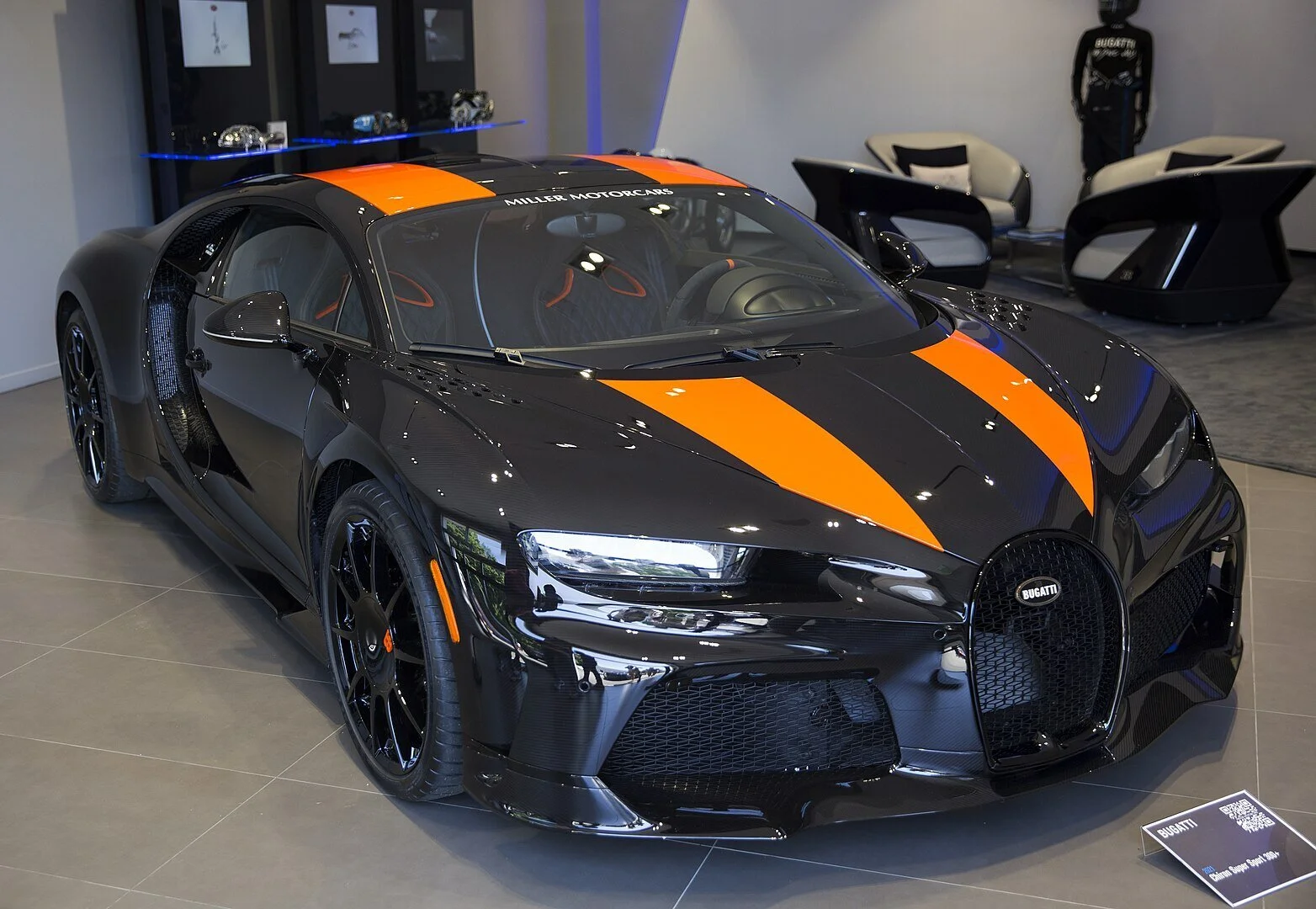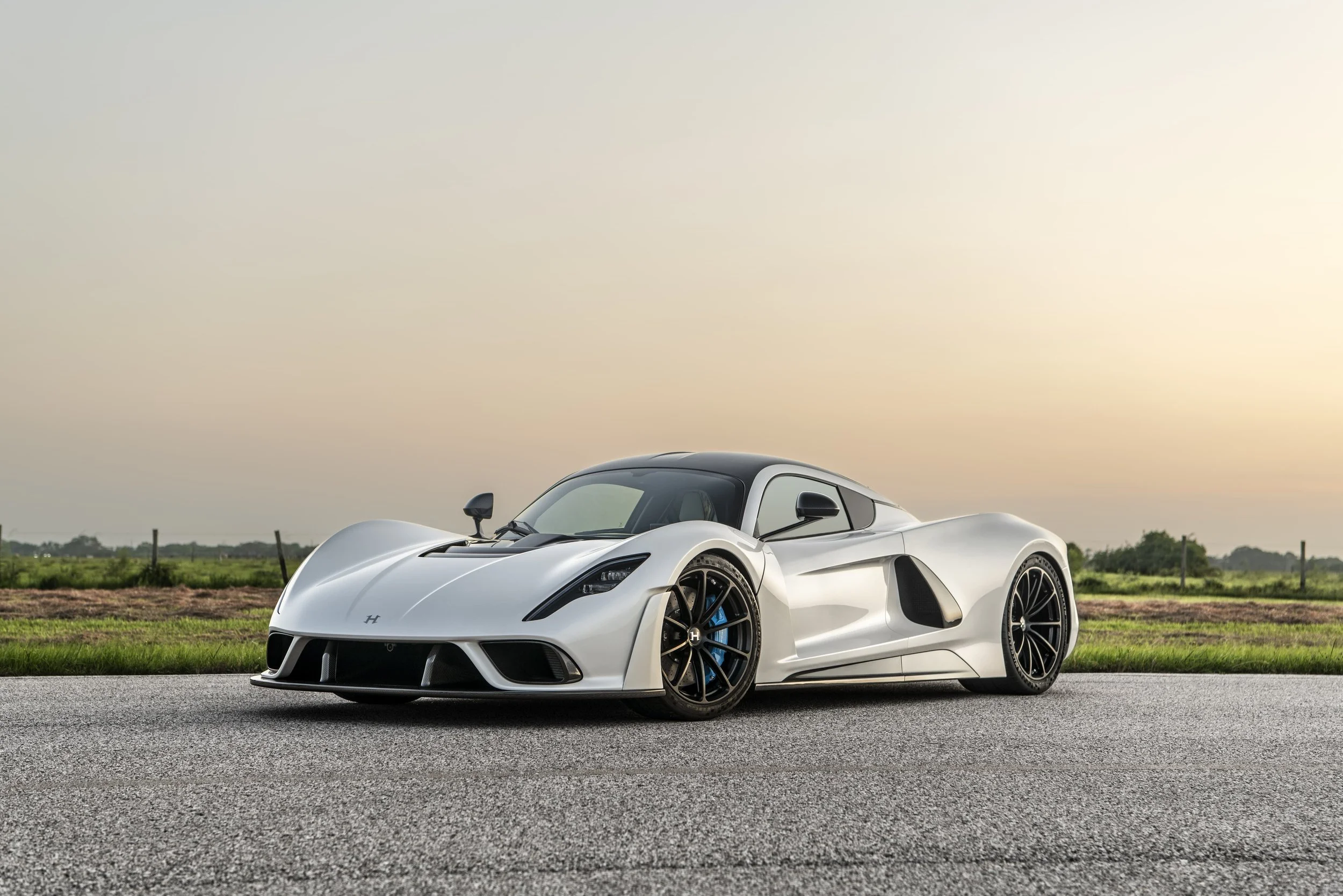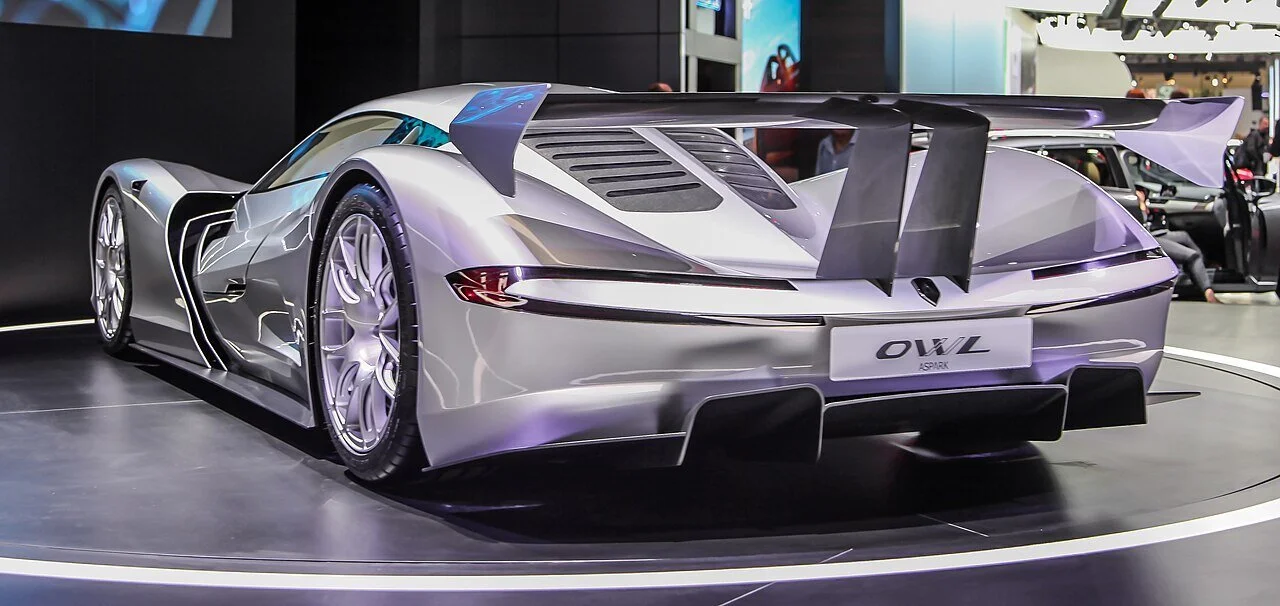Diese 5 Hypercars fahren schneller als ein Kampfjet – und du kannst sie kaufen
Kapitel 1: Vom Jet-Cockpit ins Fahrerhaus
Es ist ein uraltes menschliches Streben: schneller, weiter, extremer. Seit den ersten Automobilen vergleichen wir uns mit den Spitzenwerten der Luftfahrt. Doch was früher Science-Fiction war, ist heute Realität. Die besten Hypercars der Welt haben in den letzten Jahren nicht nur die 400-km/h-Marke pulverisiert – einige von ihnen schaffen sogar den Sprint auf 300 km/h in unter 10 Sekunden. Damit bewegen sie sich in einem Bereich, den man bislang ausschließlich Kampfjets wie der F-16 Fighting Falcon oder der Eurofighter Typhoon zugeordnet hätte.
Einige dieser Jets beschleunigen in etwa 15 bis 30 Sekunden auf Überschallgeschwindigkeit (Mach 1 = ca. 1.235 km/h auf Meereshöhe). Doch bis sie die 300 km/h-Marke knacken, dauert es überraschend lange – vor allem, wenn man sie mit einem straßenzugelassenen Fahrzeug vergleicht. Der Grund liegt in der Masse, dem Luftwiderstand beim Start und den physikalischen Anforderungen des Abhebens. Ein Hypercar hingegen wird genau dafür gebaut: brachiale Beschleunigung am Boden, ohne Rücksicht auf Komfort oder Verbrauch. Ein rollender Geschwindigkeitsrausch.
Dass sich diese beiden Welten überhaupt vergleichen lassen, ist ein Zeichen für die unglaubliche Entwicklung der Automobiltechnik in den letzten zwei Jahrzehnten. Während Supersportwagen wie der Ferrari Enzo oder der McLaren F1 noch vor 20 Jahren als Benchmark galten, haben heutige Hypercars völlig neue Maßstäbe gesetzt. Hersteller wie Bugatti, Koenigsegg, Rimac oder Hennessey bauen Fahrzeuge, die mit Raketenstart auf der Straße konkurrieren – und das oft mit Straßenzulassung.
Doch warum zieht uns dieser Vergleich zwischen Hypercar und Jet so sehr in den Bann? Vielleicht, weil beide Maschinen für absolute Grenzerfahrungen stehen. Der Pilot eines Jets und der Fahrer eines Hypercars teilen sich eine Gemeinsamkeit: den Kampf gegen die Zeit und die Grenzen der Physik. Beides sind Maschinen, die aus einem Mix aus Ingenieurskunst, Hightech-Materialien und kompromisslosem Design bestehen. Und beide erzählen Geschichten vom Aufbruch in neue Geschwindigkeitsdimensionen.
Der vielleicht größte Unterschied: Während man für das Fliegen eines Kampfjets eine militärische Laufbahn und tausende Flugstunden benötigt, genügt für viele dieser Hypercars ein gut gefülltes Konto – und ein wenig Mut. Denn obwohl die meisten Käufer ihre Fahrzeuge nie am Limit bewegen werden, wissen sie, dass sie es könnten. Allein diese Möglichkeit verleiht dem Besitz eine Aura von Macht und Exklusivität.
In diesem Beitrag stellen wir dir fünf Hypercars vor, die schneller beschleunigen als viele Kampfjets – und dabei nicht nur auf dem Asphalt, sondern auch in puncto Exklusivität, Technik und Design ihresgleichen suchen. Sie sind extrem selten, extrem teuer – und dennoch real. Sie stehen sinnbildlich für den Traum, Jetpower auf die Straße zu bringen. Und du könntest einer der wenigen Menschen sein, die so etwas besitzen.
Bereit für den Einstieg in die Welt, in der Asphalt zur Startbahn wird? Dann schnall dich an – der Countdown läuft.
Kapitel 2: Was heißt eigentlich „schneller als ein Jet”?
Der Titel klingt zunächst provokant – schließlich erreichen Kampfjets wie die F-16, F/A-18 oder der Eurofighter Typhoon Spitzengeschwindigkeiten von über 2.000 km/h, weit jenseits dessen, was selbst das schnellste Hypercar leisten kann. Doch wer diesen Vergleich wirklich verstehen will, muss tiefer in die Technik und Dynamik beider Maschinen eintauchen. Es geht hier nicht um Höchstgeschwindigkeit bei Reisehöhe – sondern um Beschleunigung aus dem Stand. Und genau hier beginnt das spannende Rennen zwischen Asphalt und Himmel.
Ein Jet benötigt – abhängig vom Modell – zwischen 15 und 30 Sekunden, um aus dem Stand auf rund 300 km/h zu beschleunigen. Diese Phase spielt sich auf einer Startbahn ab, meist mehrere hundert Meter lang. Der Grund für diese vergleichsweise „langsame“ Beschleunigung liegt in der Masse des Flugzeugs, dem Luftwiderstand in Bodennähe, der Notwendigkeit eines sicheren Abhebewinkels und der Triebwerkscharakteristik. Ein Jet arbeitet mit Turbinen, die ihren maximalen Schub erst bei hohen Drehzahlen und Geschwindigkeiten entfalten. Der Antritt aus dem Stand ist nicht ihre Paradedisziplin.
Ganz anders ein modernes Hypercar: Fahrzeuge wie der Rimac Nevera, Koenigsegg Jesko Absolut oder Bugatti Chiron Super Sport 300+ nutzen Hightech-Komponenten, Leichtbau, Allradantrieb und elektrisch unterstützte Antriebskonzepte, um in geradezu absurdem Tempo aus dem Stand zu katapultieren. Manche schaffen den Sprint von 0 auf 300 km/h in unter 10 Sekunden – also rund doppelt so schnell wie ein Jet. Diese Zahlen sind keine Theorie: Sie wurden von Fachmagazinen, Rennstrecken oder GPS-basierten Systemen bestätigt.
Entscheidend für diesen Unterschied ist nicht nur das geringe Gewicht eines Hypercars (oft unter 1.800 kg), sondern auch das Zusammenspiel von Traktion, Drehmoment und Aerodynamik. Während ein Jet mit leerem Rumpf, voller Munition oder Tanks sehr unterschiedlich performt, ist ein Hypercar auf maximale Effizienz unter Idealbedingungen ausgelegt. Im Idealfall wird der gesamte Grip der Reifen in Vortrieb umgesetzt – eine Leistung, bei der selbst Rennwagen an ihre Grenzen stoßen.
Wichtig ist also: Wenn wir hier von „schneller als ein Jet“ sprechen, geht es nicht um Top-Speed, sondern um Beschleunigung im niedrigen bis mittleren Geschwindigkeitsbereich – dort, wo ein Jet noch „anrollt“, aber ein Hypercar bereits in die zweite Getriebestufe schaltet. Auf einem Flugzeugträger würde ein Rimac Nevera also zuerst abheben – zumindest bildlich gesprochen.
Natürlich sind Jets in der Gesamtperformance uneinholbar, was Geschwindigkeit, Wendigkeit in der Luft und Flughöhe angeht. Aber genau diese technische Lücke – zwischen Startbahn und Überschall – wird von modernen Hypercars immer kleiner gemacht. In diesem engen Zeitfenster, auf vielleicht 1.000 Metern Asphalt, hat das Auto gegenüber dem Jet inzwischen oft die Nase vorn.
Und genau das macht die folgenden fünf Fahrzeuge so außergewöhnlich: Sie stehen für eine neue Ära, in der Bodenfahrzeuge die Startbahnen beherrschen – und der Begriff „Straßenrakete“ keine Übertreibung mehr ist.
Kapitel 3: Koenigsegg Jesko Absolut – Skandinavische Präzision bei Mach-Tempo
Wenn es um absolute Geschwindigkeit geht, dann gibt es einen Namen, der seit Jahren in aller Munde ist: Koenigsegg. Der schwedische Hypercar-Hersteller hat mit Modellen wie dem Agera RS oder dem Regera bereits mehrfach bewiesen, dass er keine Angst davor hat, Grenzen neu zu definieren. Doch mit dem Jesko Absolut hat Koenigsegg ein Fahrzeug gebaut, das ein einziges Ziel verfolgt: das schnellste straßenzugelassene Auto der Welt zu werden.
Während der „normale“ Jesko für die Rennstrecke konzipiert wurde – mit riesigem Heckflügel und aktivem Abtrieb – ist der Jesko Absolut radikal anders. Er ist das aerodynamischste Fahrzeug, das Koenigsegg je gebaut hat. Statt Abtrieb zu generieren, setzt der Absolut auf minimalen Luftwiderstand. Alles am Fahrzeug ist darauf optimiert, dass es bei extrem hohen Geschwindigkeiten so wenig wie möglich abbremst. Und das Ziel ist klar definiert: über 330 mph (also mehr als 530 km/h) – eine Zahl, die bislang kein Serienfahrzeug offiziell erreicht hat.
Das Herz des Jesko Absolut ist ein 5,0-Liter-V8-Biturbo, der je nach Kraftstoffart zwischen 1.280 und 1.600 PS liefert. Die Motorcharakteristik wurde so abgestimmt, dass die Kraftentfaltung auch bei hohen Geschwindigkeiten nicht nachlässt – eine Seltenheit selbst in der Welt der Hypercars. Gepaart mit dem innovativen 9-Gang-Multi-Clutch-Getriebe („Light Speed Transmission“) von Koenigsegg, sorgt das Triebwerk für eine nahezu unterbrechungsfreie Beschleunigung – mit einer Gewalt, die selbst gestandene Piloten ins Schwitzen bringt.
Obwohl Koenigsegg noch keinen offiziellen Rekord mit dem Jesko Absolut aufgestellt hat (Stand Juni 2025), ist das Fahrzeug technisch dafür ausgelegt, alle bisherigen Rekordmarken zu brechen – einschließlich der 490,48 km/h, die Bugatti 2019 mit dem Chiron Super Sport 300+ erreichte. Der einzige Grund, warum Koenigsegg diesen Rekord bisher nicht eingefahren hat? Es fehlt an einer passenden Teststrecke, die lang genug und sicher genug ist. Doch Firmengründer Christian von Koenigsegg hat mehrfach angedeutet: Es ist nur eine Frage der Zeit.
Und auch wenn du vielleicht nie in die Nähe der 500-km/h-Marke kommen wirst – allein das Wissen, dass dein Auto es könnte, macht den Jesko Absolut zu einer Ikone der Moderne. Nur wenige Dutzend Exemplare sollen gebaut werden. Der Einstiegspreis liegt jenseits der 3 Millionen Euro, doch bei Sammlern dürfte das Fahrzeug langfristig deutlich im Wert steigen.
Infokarte: Koenigsegg Jesko Absolut
Kapitel 4: Bugatti Chiron Super Sport 300+ – Der König der Geraden
Wenn ein Hypercar die Schlagzeilen dominiert, dann ist es oft ein Bugatti. Und kein Modell hat die Welt so aufgerüttelt wie der Bugatti Chiron Super Sport 300+. Am 2. August 2019 schrieb er Automobilgeschichte: Als erstes Serienfahrzeug überhaupt durchbrach er die magische Grenze von 300 Meilen pro Stunde – das entspricht 490,48 km/h. Ein Wert, der selbst in der Welt der Jets nicht alltäglich ist, und der den Bugatti in eine völlig neue Liga katapultierte.
Die Rekordfahrt fand auf dem VW-Testgelände in Ehra-Lessien statt, unter streng kontrollierten Bedingungen und mit Andy Wallace, einem Le-Mans-Sieger, am Steuer. Zwar handelte es sich um ein modifiziertes Vorserienmodell, doch Bugatti entschied sich kurz darauf, eine Kleinserie von exakt 30 Exemplaren des Chiron Super Sport 300+ zu produzieren – mit genau der Technik, die den Rekord möglich machte.
Der Chiron Super Sport 300+ ist mehr als nur ein getunter Chiron. Sein Design wurde aerodynamisch überarbeitet: längerer Hecküberhang für mehr Stabilität bei Topspeed, spezielle Michelin-Pilot-Sport-Cup-2-Reifen, modifizierter Unterboden – alles auf höchste Geschwindigkeit ausgelegt. Selbst der ikonische Bugatti-Hufeisengrill wurde verkleinert, um Luftverwirbelungen zu minimieren.
Unter der Haube steckt der bekannte 8,0-Liter-W16-Quad-Turbo-Motor, allerdings mit einer Leistung von satten 1.600 PS – also 100 PS mehr als der reguläre Chiron. Diese Power wird über ein 7-Gang-Doppelkupplungsgetriebe an alle vier Räder verteilt. Das Ergebnis: eine brachiale Beschleunigung und eine elektronisch begrenzte (!) Höchstgeschwindigkeit von 440 km/h in der Kundenvariante – um die Reifen zu schonen.
Was den Chiron Super Sport 300+ so faszinierend macht, ist nicht nur die Geschwindigkeit, sondern die Souveränität, mit der sie erreicht wird. Selbst bei über 400 km/h bleibt das Fahrzeug stabil, präzise und relativ komfortabel. Diese Kombination aus Luxus, Technik und Wahnsinn macht den Bugatti zu einem fahrbaren Mythos.
Natürlich ist der Preis ebenso exklusiv wie die Leistung: Rund 3,5 Millionen Euro netto kostet eines der 30 Fahrzeuge. Doch wer einen ergattern konnte, besitzt nicht nur ein Sammlerstück, sondern ein echtes Stück Automobilgeschichte – gebaut in Molsheim, dem traditionsreichen Sitz der Marke.
Die Produktion ist inzwischen abgeschlossen, doch der Chiron Super Sport 300+ bleibt ein Referenzpunkt in der Welt der Hypercars – als erstes Serienauto, das offiziell an der Schallmauer der Landfahrzeuge kratzte.
Kapitel 5: Rimac Nevera – Elektrischer Blitz aus Kroatien
Wenn der Begriff Gamechanger auf ein Hypercar zutrifft, dann auf den Rimac Nevera. Dieses vollelektrische Geschoss aus Kroatien hat nicht nur bewiesen, dass Elektromobilität mehr kann als Reichweite und Nachhaltigkeit – es hat die Messlatte für Beschleunigung, Technologie und digitale Fahrdynamik in neue Sphären gehoben. Der Nevera ist nicht einfach ein weiterer E-Sportwagen. Er ist ein Hightech-Meisterwerk, das aus dem Nichts zur Weltspitze aufgestiegen ist.
Benannt nach einem plötzlichen, zerstörerischen Mittelmeer-Sturm, passt der Name „Nevera“ perfekt zu seiner Leistung: 1.914 PS, 2.360 Nm Drehmoment und eine 0–100 km/h-Zeit von 1,85 Sekunden. Noch beeindruckender: Die 0–300 km/h absolviert er in nur 9,3 Sekunden – schneller als ein Jet beim Start. Damit ist der Rimac Nevera das am schnellsten beschleunigende Serienauto der Welt (Stand: 2025).
Was dieses Fahrzeug besonders macht, ist nicht nur die rohe Leistung, sondern die Art, wie sie kontrolliert wird. Vier Einzelrad-Elektromotoren ermöglichen präzises Torque Vectoring. Eine intelligente Fahrdynamikregelung analysiert in Millisekunden die Traktion jedes einzelnen Rades – und passt die Kraftverteilung an. Ergebnis: ein kontrollierbares, jederzeit beherrschbares Kraftpaket.
Die Batterie mit 120 kWh Kapazität ist flach im Chassis integriert und senkt den Schwerpunkt massiv. Sie ermöglicht eine Reichweite von bis zu 490 Kilometern (WLTP), was für ein Fahrzeug dieser Leistungsklasse bemerkenswert ist. Auch das Laden ist auf Supercar-Niveau: Dank 500-kW-Ladefähigkeit ist der Akku in rund 20 Minuten zu 80 % gefüllt – wenn die entsprechende Ladesäule zur Verfügung steht.
Das Monocoque besteht vollständig aus Carbonfaser – leicht und extrem steif. Die Produktion ist auf 150 Fahrzeuge weltweit limitiert, gefertigt im brandneuen Rimac Campus nahe Zagreb. Jeder Wagen wird weitgehend per Hand gebaut und individuell konfiguriert. Käufer können auf Wunsch ihr Fahrzeug direkt vor Ort begleiten – ein exklusives Erlebnis, das nur wenige Marken bieten.
Trotz all der Technik hat der Nevera auch eine emotionale Seite. Das Design ist elegant, fast italienisch gezeichnet, mit aerodynamischer Raffinesse und aktiven Elementen. Der Innenraum kombiniert Alcantara, Carbon und feinste Lederausstattung – auf Wunsch auch mit klassischen Instrumenten oder digitaler Renncockpit-Optik.
Der Preis liegt bei etwa 2 Millionen Euro, je nach Ausstattung. Ein hoher Preis – aber gemessen an der Leistung, Exklusivität und technologischen Brillanz ist der Rimac Nevera derzeit das Nonplusultra unter den Elektro-Hypercars. Und mit Rimac als Hauptaktionär von Bugatti-Rimac ist klar: Die Zukunft der Hypercars ist elektrisch – und sie hat ein kroatisches Herz.
Kapitel 6: Hennessey Venom F5 – Der texanische Top-Speed-Titan
Im Land der unbegrenzten Möglichkeiten war Geschwindigkeit schon immer mehr als nur ein technisches Ziel – sie ist ein Statement. Und kein anderes Hypercar verkörpert dieses amerikanische Selbstverständnis so kompromisslos wie der Hennessey Venom F5. Entwickelt, um die 500-km/h-Schallmauer zu durchbrechen, ist er ein puristischer Kraftprotz auf Rädern – gebaut in Texas, aber mit globalen Ambitionen.
Die Namensgebung ist alles andere als Zufall: F5 steht für die höchste Stufe auf der Fujita-Skala für Tornados. Ein F5-Tornado erreicht Windgeschwindigkeiten von bis zu 512 km/h – und genau das ist die Zielmarke für den Venom F5. Während Bugatti und Koenigsegg ihre Modelle auf höchster Ingenieursebene verfeinern, setzt Hennessey auf brutale Leistung und radikale Leichtbauweise.
Das Herzstück des Fahrzeugs ist der „Fury“ getaufte V8-Motor – eine vollständige Eigenentwicklung von Hennessey. Der 6,6-Liter-V8 mit Doppelturboaufladung leistet sage und schreibe 1.842 PS und generiert ein maximales Drehmoment von 1.617 Nm. Gepaart mit einem Trockengewicht von nur 1.360 kg ergibt sich ein Leistungsgewicht, das jede Superlative rechtfertigt.
Die Beschleunigungswerte sprechen für sich: 0–100 km/h in unter 2,6 Sekunden, 0–200 km/h in unter 5 Sekunden und 0–400 km/h in unter 16 Sekunden (Stand: interne Tests). Die Höchstgeschwindigkeit liegt offiziell bei 484 km/h, doch das erklärte Ziel von Firmengründer John Hennessey bleibt klar: über 500 km/h – und damit die Krone der Hypercar-Welt.
Der Venom F5 basiert auf einem vollständig neu entwickelten Carbonfaser-Monocoque, das von Delta Motorsport in Großbritannien mitentwickelt wurde. Die Karosserie ist ebenfalls aus ultraleichtem Carbon gefertigt. Das Ergebnis ist eine Steifigkeit auf LMP1-Niveau – mit einem Gewicht, das viele Supersportwagen hinter sich lässt.
Innen herrscht Rennwagen-Flair: ein Cockpit, das stark vom Flugzeugbau inspiriert ist, mit einem Jet-ähnlichen Lenkrad, minimalistischen Anzeigen und Fokus auf Fahrerzentrierung. Komfort? Fehlanzeige – hier zählt Performance. Dennoch lassen sich auf Wunsch individuelle Anpassungen in Leder, Alcantara oder Sichtcarbon umsetzen.
Produziert wird der Venom F5 in extrem kleiner Stückzahl: nur 24 Fahrzeuge weltweit, alle größtenteils handgefertigt in Sealy, Texas. Preislich liegt der F5 je nach Ausstattung zwischen 2,3 und 2,7 Millionen Euro. Die Kunden – meist Sammler und Rennsport-Enthusiasten – erhalten nicht nur ein Auto, sondern ein Stück purer amerikanischer Ingenieurskunst.
Der Hennessey Venom F5 ist mehr als nur ein Auto. Er ist eine Machtdemonstration – ein klares Statement, dass die Vereinigten Staaten im Wettlauf um das schnellste straßenzugelassene Fahrzeug der Welt ganz vorne mitspielen.
Kapitel 7: Aspark Owl – Lautlose Lenkwaffe aus Japan
Während Europa und Amerika im Rennen um die schnellsten Hypercars der Welt meist die Schlagzeilen dominieren, hat sich ein kaum bekannter Name aus Japan heimlich in die Elite gefahren: Aspark. Mit dem Owl – japanisch für „Eule“ – hat das Unternehmen eines der extremsten Elektro-Hypercars aller Zeiten geschaffen. Lautlos, kompromisslos, unfassbar schnell.
Die Geschichte des Aspark Owl beginnt ungewöhnlich. Aspark ist eigentlich ein Ingenieursdienstleister, gegründet in Osaka, Japan, mit Fokus auf Technologieprojekte. Doch Gründer Masanori Yoshida hatte eine Vision: das schnellste beschleunigende Auto der Welt zu bauen – vollelektrisch. Das Resultat ist ein Fahrzeug, das physikalische Grenzen verschiebt.
Der Aspark Owl schafft die Beschleunigung von 0 auf 100 km/h in 1,72 Sekunden – ein Rekordwert für ein straßenzugelassenes Serienfahrzeug (Stand 2025). Diese unfassbare Kraft stammt von vier Elektromotoren, die gemeinsam eine Leistung von 2.012 PS erzeugen. In Verbindung mit einem maximalen Drehmoment von 2.000 Nm entfaltet der Owl eine brachiale Gewalt – und das nahezu geräuschlos.
Die Höchstgeschwindigkeit liegt bei 413 km/h, was ihn nicht nur zum schnellsten japanischen Elektroauto, sondern auch zu einem der schnellsten E-Fahrzeuge der Welt macht. Doch Aspark geht es nicht nur um Speed, sondern auch um Design. Der Owl ist mit 99 cm Höhe das flachste Hypercar der Welt. Seine langgezogene Karosserie mit Butterfly-Türen, Carbonflächen und aktiver Aerodynamik wirkt fast wie ein Konzeptfahrzeug aus einem Sci-Fi-Film – und ist doch real.
Der Owl wird nicht in Japan, sondern in Kooperation mit dem italienischen Karosseriebauer Manifattura Automobili Torino (MAT) gebaut. Jedes der lediglich 50 geplanten Fahrzeuge entsteht in sorgfältiger Handarbeit. Der Monocoque-Rahmen besteht vollständig aus Carbonfaser, ebenso wie die Karosserie – was trotz großem Akkupaket ein Trockengewicht von nur 1.900 kg ermöglicht.
Die verbaute Batterie liefert 64 kWh Kapazität und ermöglicht eine Reichweite von bis zu 450 km. Geladen wird mit 44 kW DC oder 22 kW AC – was für ein Hypercar dieser Liga akzeptabel ist. Im Gegensatz zu westlichen Elektroboliden liegt der Fokus weniger auf Langstreckentauglichkeit, sondern auf ultimativer Leistung auf kurzen Etappen.
Im Innenraum zeigt sich der Owl puristisch, aber luxuriös: Zwei digitale Displays, Sportlenkrad, edles Leder und Carbon – alles in Handarbeit verarbeitet. Der Fahrer sitzt extrem tief, fast wie in einem Le-Mans-Prototypen. Doch trotz der Rennwagen-Anmutung ist der Owl für die Straße zugelassen – mit allen nötigen Sicherheits- und Assistenzsystemen.
Der Preis? Rund 3 Millionen Euro, je nach Konfiguration. Dafür bekommt man nicht nur ein Fahrzeug, sondern ein Symbol japanischer Präzision, Geduld und Ingenieurskunst. Und wer einen Owl besitzt, hält einen elektrischen Mythos in den Händen – leise, selten und unfassbar schnell.
Kapitel 8: Wie man ein solches Hypercar überhaupt kaufen kann
Die fünf vorgestellten Hypercars – Jesko Absolut, Chiron Super Sport 300+, Rimac Nevera, Venom F5 und Aspark Owl – zählen zweifellos zu den exklusivsten Maschinen, die je auf vier Rädern gebaut wurden. Doch so faszinierend ihre Leistungsdaten sind, stellt sich für viele die Frage: Wie kauft man so ein Fahrzeug überhaupt? Gibt es ein Bestellformular? Geht man einfach zum nächsten Händler? Die Antwort ist: Jein. Der Kauf eines Hypercars ist ein eigener Kosmos – und für viele Sammler sogar Teil des Reizes.
1. Exklusivität beginnt mit Zugang
Anders als bei Serienfahrzeugen steht bei Hypercars nicht der klassische Verkaufsprozess im Vordergrund. Viele dieser Fahrzeuge sind auf wenige Dutzend Einheiten limitiert – teilweise noch bevor ein serienreifes Modell überhaupt gezeigt wurde. Hersteller wie Bugatti, Koenigsegg oder Rimac informieren ausgewählte Kunden persönlich und vergeben Kaufoptionen lange im Voraus.
Um überhaupt in den Käuferkreis zu gelangen, braucht es entweder Beziehungen, einen Ruf als Sammler oder ein Portfolio aus vorherigen Käufen. Wer beispielsweise bereits einen Bugatti Veyron oder Divo besitzt, hat eine höhere Chance, bei der Verteilung eines Chiron Super Sport 300+ berücksichtigt zu werden.
2. Direkt beim Hersteller oder über spezialisierte Händler
Bei Marken wie Koenigsegg oder Rimac läuft der Vertrieb oft direkt über das Werk oder ausgewählte Exklusivpartner. Diese pflegen enge Kontakte zu bestehenden Kunden, sammeln Vorbestellungen und begleiten die gesamte Kaufabwicklung – vom Konfigurator bis zur Auslieferung.
Bugatti oder Hennessey wiederum arbeiten über ein Netz aus zertifizierten Partnern oder Luxushändler, die teilweise Showrooms mit eigenen Lounge-Bereichen betreiben. Hier kann man Fahrzeuge besichtigen (soweit verfügbar), Konfigurationen durchführen und Verträge abschließen. Doch: Die eigentliche Bestellung wird häufig vom Hauptsitz finalisiert.
3. Eventbasiertes Networking
Ein guter Einstieg in diese Welt sind exklusive Hypercar-Events, bei denen neue Modelle enthüllt oder getestet werden – z. B. der Supercar Owner Circle, Top Marques Monaco, Goodwood Festival of Speed oder der Concours d’Elegance Pebble Beach. Dort lassen sich Herstellervertreter treffen, Kontakte knüpfen und sich als potenzieller Käufer positionieren.
Nicht selten entscheiden sich Hersteller direkt vor Ort, wer einen Platz auf der Warteliste erhält. Auch limitierte Sondermodelle oder Homologations-Serien werden oft nur auf Einladung dieser Events angeboten.
4. Gebrauchtmarkt & spezialisierte Plattformen
Wer leer ausgegangen ist, kann auf dem Sekundärmarkt fündig werden – oft sogar mit geringen Laufleistungen, da viele Hypercars als Sammlerobjekte gar nicht bewegt werden. Plattformen wie:
JamesEdition
duPont Registry
Tom Hartley Jnr.
Paganistore (für Pagani)
RMSotheby’s oder Bonhams (für Auktionen)
bieten regelmäßig Hypercars an. Die Preise liegen hier allerdings häufig über dem Listenpreis, besonders bei limitierten Fahrzeugen, die bereits ausverkauft sind.
5. Investieren statt fahren: Digitale Beteiligungsmodelle
Eine spannende Alternative für Enthusiasten mit kleinerem Budget sind digitale Beteiligungsplattformen wie:
Timeless Investments (DE)
Rally Rd. (USA)
CarCrowd (UK)
Collecting Cars Invest
Hier kannst du Anteile an echten Hypercars erwerben – z. B. am Koenigsegg Regera oder einem McLaren P1 – ohne selbst Eigentümer oder Fahrer zu sein. Der Fokus liegt auf Wertsteigerung und digitalem Handel, ähnlich wie bei Aktien. Zwar fährt man das Auto nicht selbst, aber man partizipiert an der Entwicklung – eine Art „virtuelles Garagenstück“.
6. Aufpassen bei Grauimporten & Zwischenhändlern
Der Hypercar-Markt ist auch ein Spielfeld für windige Anbieter. Manche Fahrzeuge werden als „EU-Neu“ oder „Limited Edition“ angeboten, obwohl es sich um nicht homologierte Prototypen oder Umbauten handelt. Wer über Dritthändler kauft, sollte sich unbedingt Zertifikate, Matching Numbers, Originalverträge und Servicehistorien vorlegen lassen.
Ein fehlender CoC (Certificate of Conformity) oder ein unvollständiges Zulassungsdokument kann schnell bedeuten, dass ein Fahrzeug nicht auf öffentlichen Straßen zugelassen werden darf – selbst wenn es technisch fahrbereit ist.
Kapitel 9: Fazit – Jetpower für die Straße, aber mit Stil
Es gibt Dinge, die man nicht rational erklären kann – man muss sie fühlen. Hypercars gehören in genau diese Kategorie. Sie sind mehr als Fortbewegungsmittel. Sie sind Statements, Symbole menschlicher Schöpfungskraft, technologische Grenzverschiebung – und in ihren extremsten Ausprägungen sogar schneller als ein Kampfjet im Startlauf.
Was wir in diesem Beitrag gesehen haben, ist eine Momentaufnahme eines nie endenden Wettlaufs. Ein Rennen zwischen Leistung, Physik, Materialgrenzen und Ingenieurskunst. Der Koenigsegg Jesko Absolut, der Bugatti Chiron Super Sport 300+, der Rimac Nevera, der Hennessey Venom F5 und der Aspark Owl – sie alle sind Ergebnisse eines kompromisslosen Anspruchs: das Unmögliche möglich zu machen.
Geschwindigkeit jenseits des Vorstellbaren
Dass ein Fahrzeug heute in unter 10 Sekunden auf 300 km/h beschleunigen kann – schneller als ein Jet beim Start – war vor wenigen Jahren noch unvorstellbar. Doch die Kombination aus Leichtbau, innovativer Aerodynamik, digitaler Fahrdynamikregelung und brachialer Motorleistung hat genau das ermöglicht.
Dabei spielt es keine Rolle, ob die Kraft aus einem elektrisch fiependen 4-Motoren-System wie beim Rimac Nevera oder aus einem feuerspeienden Biturbo-V8 wie im Venom F5 kommt – entscheidend ist die Wirkung: ein Adrenalinstoß, der jeden Quadratmillimeter Asphalt in einen Startplatz verwandelt.
Mehr als Zahlen: Hypercars als emotionale Ikonen
So beeindruckend die technischen Werte sind, so faszinierend ist auch die Aura, die jedes dieser Fahrzeuge ausstrahlt. Der Jesko Absolut ist ein Beispiel für skandinavische Präzision und technische Bescheidenheit, die in pure Geschwindigkeit mündet. Der Chiron Super Sport 300+ vereint französischen Luxus mit brutaler Kraft – ohne dabei jemals die Contenance zu verlieren. Der Venom F5 schreit förmlich nach Rebellion, nach Unabhängigkeit von europäischen Normen und deutschen Limitierungen.
Und dann ist da noch der Aspark Owl – ein Fahrzeug, das aus dem Nichts kam und die Szene aufmischte wie ein lautloser Blitz. Hier zeigt sich, dass Hypercars nicht nur Maschinen, sondern kulturelle Botschafter sind. Jedes Modell steht für ein Land, ein Konzept von Ästhetik, von Fortschritt, von Zukunft.
Zwischen Traum und Wirklichkeit
Natürlich: Die allerwenigsten Menschen werden jemals einen dieser Wagen besitzen – geschweige denn fahren. Aber darum geht es nicht. Hypercars sind die Formel 1 der Straße, die Krone des Machbaren. Und so wie ein Raumfahrtprogramm die technologische Entwicklung ganzer Branchen beschleunigt, wirken auch Hypercars auf den Rest der Automobilwelt.
Die Keramikbremsen, Aerodynamiksysteme, elektronischen Assistenzhelfer und Fahrwerkslösungen, die heute in Oberklasse-Limousinen zum Einsatz kommen, entstanden oft zuerst in einem Hypercar. Sie sind Innovationsinkubatoren, Testfelder für Materialien und Konzepte, die in Zukunft Millionen Autofahrer sicherer, effizienter oder schlicht glücklicher machen könnten.
Wertanlage, Statussymbol – oder fahrbares Kunstwerk?
Ein weiterer Aspekt ist nicht zu unterschätzen: Hypercars sind längst auch Investments. Ihre Limitierung, ihre technische Singularität und ihre emotionale Aufladung sorgen dafür, dass viele Modelle nach wenigen Jahren mehr wert sind als beim Kauf.
Ein Bugatti Chiron Super Sport 300+, der für rund 3,5 Millionen Euro verkauft wurde, wird heute bereits auf dem Sekundärmarkt für 4 bis 5 Millionen gehandelt – mit Tendenz steigend. Auch ein Jesko Absolut, dessen Stückzahl streng begrenzt ist, dürfte zu einem begehrten Sammlerstück werden – selbst wenn er nie den 530 km/h-Rekord knackt.
Doch es wäre schade, Hypercars nur auf ihren Wertzuwachs zu reduzieren. Sie sind vor allem auch fahrbare Kunstwerke, geschaffen mit derselben Liebe zum Detail wie ein handgefertigter Chronograph oder ein Gemälde von Gerhard Richter. Wer das Glück hat, eines dieser Fahrzeuge zu bewegen, erlebt nicht einfach eine Fahrt – sondern eine Art Performance.
Die Zukunft? Grenzübergreifend – leise und wild zugleich
Ein Blick in die Glaskugel zeigt: Die Hypercar-Welt steht vor einem Umbruch. Elektrifizierung, Wasserstoff, Leichtbau durch neue Materialien und die Integration von künstlicher Intelligenz werden das Segment weiter transformieren. Marken wie Rimac, Lotus (Evija) oder Pininfarina (Battista) zeigen bereits, dass Performance und Nachhaltigkeit kein Widerspruch sind.
Doch eines wird sich nicht ändern: Hypercars werden immer das Extrem suchen, werden immer ein wenig verrückt, ein wenig überflüssig – und gerade deshalb so begehrenswert sein. Weil sie das verkörpern, was sonst in unserer durchregulierten Welt selten geworden ist: Freiheit.
Schlusswort:
Ob auf dem Asphalt, im Sammlerraum oder einfach als Inspiration: Hypercars sind die modernen Kathedralen der Geschwindigkeit. Sie zeigen, was möglich ist, wenn alles erlaubt ist – und wenn Träume nicht aufgeben, sondern in Kohlefaser gegossen werden.
Vielleicht wirst du nie selbst in einem Jesko sitzen. Aber die Faszination, die sie ausstrahlen, ist für jeden spürbar. Und vielleicht beginnt genau dort die Reise – mit einem Traum, der 300 km/h schneller ist als der eines Kampfjetpiloten.
🔗 Weiterführende Links & Empfehlungen
Weitere Blog- und Newsartikel auf hypercars.pro
Von 0 auf 300 in unter 10 Sekunden – Die schnellsten Serienfahrzeuge der Welt
Technologische Meisterwerke: Die innovativsten Features moderner Hypercars
Glamour, Power und Quad-Turbo-Performance: Der neue Giamaro Katla sprengt alle Grenzen
Exklusive Events & Reisen
Goodwood Festival of Speed 2025 – Jetzt Tickets sichern
Top Marques Monaco – Die exklusivste Autoshow Europas
Supercar Owner Circle – Zugang für Gäste möglich
oder schaue in unserem Eventbereich vorbei: hier
Hypercar kaufen oder investieren?
Falls du nicht nur träumen willst:
JamesEdition – Aktuelle Angebote für Koenigsegg, Pagani & Co.
Social Media & Newsletter
Bleib immer auf dem neuesten Stand über Hypercar-Neuvorstellungen, Rekorde und Insiderwissen:
Folge uns auf Instagram
Werde Teil unserer Facebook-Community
















